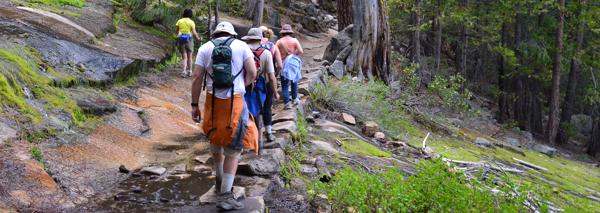
Glissading is not only a great way to get off a mountain fast, it is also a lot of fun if you know what you are doing. The sitting glissade is by far the most stable, and is featured here by David Koerner in the video above. Before you get started, make sure to get in some practice on slopes with a safe run-out. When I say safe run-out I mean slopes that do not end in cliffs, rocks, crevices, or other such dangers. The south slopes of Mt Shasta offer several areas where you can safely practice the art of glissading (The north slopes of Shasta are heavily creviced. So avoid that side of the mountain for this type of practice.)
Make sure to take off your crampons when glissading. Crampon points can catch in patches of ice and this could easily send you tumbling head over heals down the mountain. I have also heard of accounts from people who have seen or heard of people who broke ankles while glissading with crampons on.
So make sure to remove them before setting off on your slide. Gaiters can also be very useful when glissading because they protect the calves of your legs from abrasion on sharp ice. I remember sliding down the same section as shown above on Mt Shasta, and having the skin on my calves completely torn away which left a trail of blood behind on the ice. So wear your gaiters. Gortex or rain pants can also be very helpful when glissading. They not only give you a faster ride, but they also protect your inner clothing from getting soaked during the ride down.
Now for the more technical stuff. When glissading, try to slightly bend your knees. This gives you a slight advantage for shock absorption. For a brake, use the spike of your ice ax like a rudder along the snow on one side of you. Make sure to keep both hands on the ax in order to maintain control. Putting pressure on the spike helps reduce speed and helps keep your posture in check so you do not tend to lean forward too much.
To stop, apply more downward pressure to the ax, and dig in your heals a bit more if you are in softer snow. If you are on snow that is hard packed, (or on an icy slope), you will most likely have to self arrest. To do this, roll over on your belly in order to get into a self arrest position. Then use the pick of your ice ax to bring yourself to a halt.
Well, that's about it for the sitting glissade. There is also the standing glissade, and the crouching glissade. These types of activities are much more difficult to master than the sitting glissade, and require a lot of balance. They are similar to snow skiing, but with less control.
We used a lot of terms here, and not all of you will be familiar with them. When time permits we will add additional information about the ice ax, crampons, and other mountaineering equipment.

|
Join the Adventure! Sign up here for Timberline Trails Monthly Newsletter |

Join us on Instagram

©2006-2024 TimberlineTrails. All Rights Reserved.
....